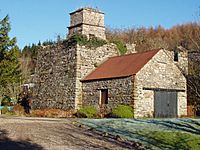Furnace, Argyll facts for kids
Quick facts for kids Furnace
|
|
|---|---|
 The old iron furnace |
|
| OS grid reference | NN 02477 00182 |
| Council area | |
| Lieutenancy area |
|
| Country | Scotland |
| Sovereign state | United Kingdom |
| Post town | INVERARAY |
| Postcode district | PA32 |
| Dialling code | 01499 |
| EU Parliament | Scotland |
| UK Parliament |
|
| Scottish Parliament |
|
Furnace (which means "The Furnace" in Scottish Gaelic, An Fhùirneis) is a small village in Argyll and Bute, on the west coast of Scotland. It sits on the northern shore of Loch Fyne, which is the longest sea loch (a narrow arm of the sea) in the United Kingdom. Furnace is located about eight miles southwest of Inveraray along the A83 road.
Unlike many villages in the West Highlands of Scotland, Furnace has an interesting industrial past. Besides farming and fishing, the village was once home to three main businesses: an iron furnace, gunpowder mills, and a quarry.
Contents
The Old Ironworks
The ironworks were started in 1755 by a company from Cumbria called Duddon. They chose this spot because the local forests could provide plenty of charcoal. Charcoal was needed to smelt iron, which means melting iron ore to get pure iron.
The village was originally called Inverleacainn (meaning "the mouth of the River Leacainn"). Over time, people started calling it "the furnace," and eventually, it just became "Furnace." The iron furnace stopped working in 1812. Today, the site is a scheduled monument, meaning it's an important historical place.
Loch Fyne Powderworks
The same charcoal that helped the iron furnace also supported the next big industry: making gunpowder. Gunpowder is made from charcoal, sulphur, and saltpetre. The Loch Fyne Powderworks was built in 1841.
The company faced criticism for its safety. For example, a large storage building holding 80 tons of gunpowder was only 80 metres from the village school! In 1883, the Powderworks exploded. The only person hurt was the manager, William Robinson, who was at home nearby and sadly died from flying debris.
The Quarry
The third important industry in Furnace was the quarry, which opened in 1841. It is still working today! This quarry supplied cobbles (round stones) for the streets of Glasgow. It was once the biggest employer in the area, with over 200 men cutting the pink granite by hand.
Today, the quarry is fully mechanised, meaning machines do most of the work. It now produces crushed stone and concrete and employs a small team of 3-4 people.
Furnace and the Camanachd Cup
In the Scottish sport of shinty, the Furnace team holds a special record. In 1923, they won the top national competition, the Camanachd Cup. They beat Newtonmore 2–0 in Inverness. What's amazing is that they won the entire competition without letting the other teams score a single goal against them! This amazing feat was not matched until 2013 by Newtonmore.
Famous People from Furnace
- The Gaelic poet Evan MacColl was born in 1808 in Kenmore, a small area on the edge of Furnace. He wrote famous poems like "The Mountain Minstrel." A stone cairn (a pile of stones used as a monument) was built in his memory in 1930.
- Moira Cameron, the first female Beefeater at the Tower of London, is from Furnace. She was appointed in 2007.
Furnace Today
Furnace today looks very different from its busy industrial past. Back when the quarry employed 200 stone-cutters alone, the village was much larger. In 2008, Furnace had a total population of just over 200 people, many of whom are retired.
One important source of work today is fish farming, with eight people working at the Furnace Hatchery. The village primary school, which had 40 pupils in the 1930s, now has 24. Of seven local shops that once existed, only one remains, along with The Furnace Inn and a post office. The village also has a health centre, a visiting dentist, a sports pitch, and a children's play park.
The Leacainn Walk is a six-mile circular path that starts from the village. It follows some old drover’s roads (paths used to move livestock) and crosses the River Leacainn. Villagers created this walk as a millennium project to celebrate the year 2000.


